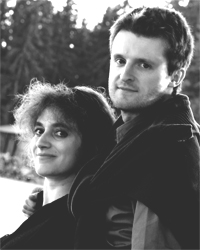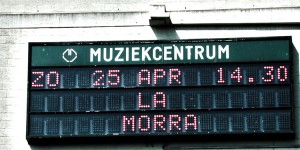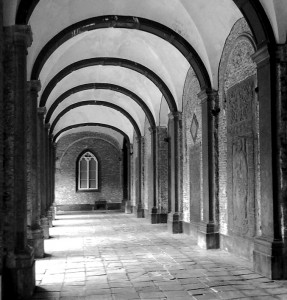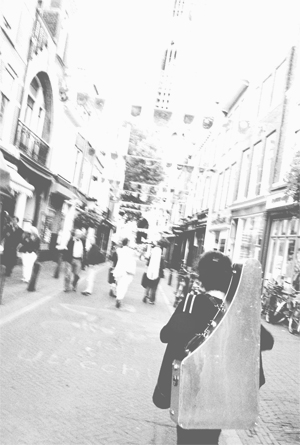IN A NUTSHELL
La Morra is well-established as one of the leading European ensembles for Late Medieval and Early Renaissance art music. A melting pot of nationalities, LA MORRA makes its home in Basel, the cosmopolitan cultural capital of Switzerland, a town with decades-long tradition in research and performance of ‘early music’. Under the artistic leadership of Corina Marti and Michal Gondko, LA MORRA re-defines itself according to the requirements of the projects it undertakes. Founded and led by two instrumentalists, the ensemble takes its name from an instrumental piece by Henricus Isaac.
THE LONGER STORY
It started like it often does. Young and fearless, you go to study somewhere far away from home; you meet new people, study and make music during the day, party and dream at night – together. ‘It was a crazy but a great time back then, in the late 1990s / early 2000s in Basel’.

In music, as in life, some relationships are meant to last while other are not. Corina and Michal‘s lives centered on their common dream: their own ensemble. ‘All we wanted was (and still is!) to make the music we love with the people we like; and if we could make a living from it – all the better’.
Nobody likes competitions, but they can be helpful. In 2000, « La Morra » was selected to participate in the International Young Artist Presentation in Antwerp. Officially not a competition, but there was a prize to win. ‘We didn’t win it. But judging by some performance and recording invitations that followed, we won something more important.’
Those were the days before YouTube and to have one’s own recording on the market was crucial. ‘Back in Basel, we summoned all our courage and sought help from the director of the Schola Cantorum Basiliensis (where we were still students). We didn’t expect this to work. «What is it that you’d like to record and what is earliest you can do the recording session?» is what we heard back’. La Morra’s first album, Le Jardin de Plaisance, supported by the Schola Cantorum Basiliensis, hit the store shelves in 2003 (yes, there were still record stores with actual CDs on the shelves back then!).

By the end of the decade, La Morra had three more recordings out and toured across Europe, making appearances at such events as Festival van Vlaanderen (various branches) and Utrecht Festival. When the city of Mechelen prepared to celebrate its sixteenth-century regent, Marguerite of Austria, Belgian Radio VRT-Klara invited La Morra to make a recording for the occasion. The result, Dame de Deuil, was presented and performed in Mechelen during the event Mechelen 2005: City in Female Hands. ‘They even brew a special beer for the occasion!’. Around this time, with Flour de Beaulté, La Morra begun a fruitful partnership with the label Ramée (which was also to harbour Corina and Michal’s duo project Von edler Art and their respective solo projects). Favorable reviews with highest marks begun appearing in the international music press.
The CD Ex libris doctoris Amerbachii – produced, again, by the Schola Cantorum Basiliensis – was a clear sign that the ensemble has put down roots in Basel. ‘This small city at the crossroads of Switzerland, Germany and France has a magnetic attraction for all who want to study « early music ». Where else can you find a University of Early Music and three excellent libraries full of anything one could ever wish for – all within a few minutes of a bike ride? And an airport 20 minutes away from the city centre? This is why so many of us from all over the world have come to study here, and many have settled here for good.’ Ultimately, this was also one of the main reasons to keep an open formula for the ensemble. ‘With so many colleagues, excellent specialists in their respective fields, a few streets away – why keep a narrow repertoire profile?’ And there was something else. ‘Basel is a city of the arts, both past and present, and cherishes its own heritage, which is constantly inspirational. It is Switzerland’s cultural heart’. Later, La Morra released another disc devoted to Basel’s musical past (Armoniae Celestes, Carmina Suavissima).

The next decade opened with a special event. The ensemble was honoured with a concert marking the first decade of ensemble’s existence in the Schola Cantorum Basiliensis’ concert series Freunde Alter Musik Basel. In 2008, Jérôme Lejeune of Ricercar asked La Morra to participate in a fascinating recording project – the complete works of Johannes Ciconia. La Morra was entrusted with recording Ciconia’s secular works. Released in time for the 600th anniversary of the composer’s death, the box won a considerable critical acclaim, earning the Grammophone Award Nomination, Diapason d’Or as well as both Preis and Jahrespreis der Deutschen Schallplattenkritik. ‘Many beautiful concerts with Ciconia’s music followed, but the one in the collegiate church of Saint-Jean-L’Évangéliste in Liège – where Ciconia sung as a choirboy – had a symbolic significance for us.’

There followed two albums with the Early Renaissance repertoire (Luz del Alva (2012), nominated for the International Classical Music Awards; and The Lion’s Ear, (2016) which was honoured with Noah Greenberg Award (2014) by the American Musicological Society), and one devoted to the 15th-century musical culture of Central Europe and its best exponent, the Latin poet-composer Petrus Wilhelmi de Grudencz.
Splendor da ciel (2018) explores the repertoire recovered from the so-called San Lorenzo Palimpsest, focusing on hitherto unknown (and thus not previously recorded) works by Florentine composers such as Giovanni and Piero Mazzuoli, as well as new readings for compositions known from other contemporary manuscripts.
Looking back at nearly 25 years of busy performers’ life, has anything changed? ‘Perspective on some things must needs change, but our fascination and dreams are still the same. We get just as excited about the music and ideas as we did back then. There is still so much music out there, and so much to look forward to.’
CONCERT REVIEWS
-
SCHERZO (2022): ‘(…) las grabaciones de La Morra para el sello discográfico Ramée se han convertido en un icono para los amantes de la música tardomedieval y renacentista… el sonido del grupo es igual de coruscante que en grabación… La Morra fue desgranando las piezas del programa con una delicadeza exquisita, sin tener que prescindir en ningún momento del rigor musicológico que le caracteriza… Actuaciones como esta de La Morra son las que hacen falta para que la música medieval, al menos por estos pagos, deje de ser contemplada como una extravagancia.’ [full review]
-
EL PAÍS (2017): ‘[El] grupo infalible y de enorme calidad’
-
EL PAÍS (2015): ‘El Ensemble La Morra interpretó música inglesa del siglo XV con el mismo grado de sutileza y respeto con que ofreció aquí música de Ciconia hace dos años y rozó el mismo cielo que alcanzó el día anterior Paul O’Dette, el veterano laudista estadounidense que ha conseguido ese imposible logrado por muy pocos instrumentistas: la identificación total y absoluta con un compositor.’
-
NAUMBURGER TAGBLATT (2015): ‘Großartige Künstler…’
-
AUDIOCLASSICA.COM (2013): ‘El concierto fue calando en el público… En un hipotético podio de los mejores conciertos del Festival, el de La Morra tendría que ocupar sin duda uno de los puestos de privilegio.’ read more
-
VÅRT LAND (2012): ‘Det var en deilig time.’
-
GAZETA WYBORCZA (2011): ‘Artysci zachwycali gra pelna emocji, perfekcji i lekkosci jednoczesnie…’ read more
-
DIE SÜDOSTSCHWEIZ (2011): ‘Auf höchstem musikalischen Niveau gespielt…’
-
LALIBRE.BE (2010): ‘Une pureté et une ferveur éminemment touchantes…’
-
TOCCATA (2010): ‘Überzeugend, harmonisch, mit schönem Gleichklang, flüssig vorgetragen.’
-
EARLY MUSIC REVIEW (2010): ‘One of the highlights…’
-
MITTELBAYERISCHE ZEITUNG (2010): ‘Entrückt und engelhaft.’ read more
-
BASELLANDSCHAFTLICHE ZEITUNG (2008): ‘Was La Morra bot, war in seiner ausgewogenen Schönheit jedenfalls himmelweit entfernt vom falschen Cliché des finsteren Mittelalters und sorgte beim Publikum für grosse Begeisterung.’
-
DE STENTOR – ZWOLSE COURANT (2004): ‘Zuiverheid lijkt het parool bij La Morra…’
-
DIARIO DEL ALTOARAGON (2003): ‘Impresionante virtuosismo… la atmosfera medieval mas delicada e intimista…’